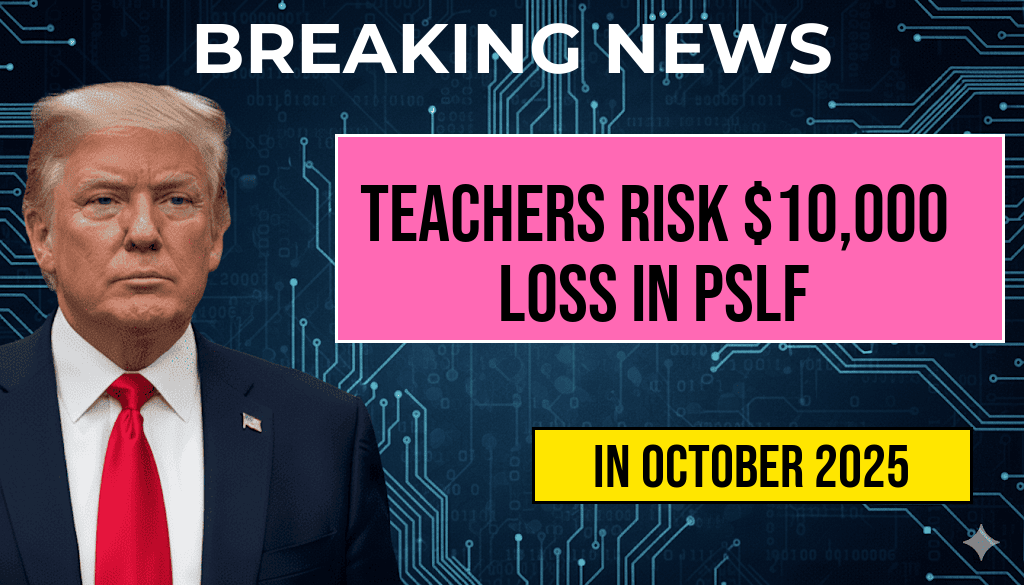Teachers across the United States may face significant financial repercussions due to changes in the Public Service Loan Forgiveness (PSLF) program, with many potentially losing over $10,000 in expected loan forgiveness. The PSLF program, designed to alleviate student debt for educators and other public service workers, has stringent requirements that can complicate eligibility. As these educators approach the critical threshold of 120 qualifying payments, it is crucial for them to monitor their progress closely to ensure they do not miss out on the benefits intended to support their careers in public service.
Understanding the PSLF Program
The PSLF program was established to encourage individuals to pursue careers in public service by forgiving the remaining balance on their Direct Loans after they have made 120 qualifying monthly payments while working full-time for a qualifying employer. However, recent reports indicate that many educators are unaware of the specific eligibility criteria that can affect their loan forgiveness.
Eligibility Requirements
- Employment Status: Borrowers must work full-time for a government or not-for-profit organization.
- Loan Type: Only Direct Loans qualify for forgiveness. Federal Family Education Loans (FFEL) and Perkins Loans do not qualify unless consolidated into a Direct Consolidation Loan.
- Payment Plans: Payments must be made under a qualifying repayment plan, such as an income-driven repayment plan.
How Changes Impact Teachers
Many teachers have reported confusion regarding their payment counts and eligibility. The U.S. Department of Education has made adjustments to the PSLF program, which can lead to disqualifications if not properly monitored. For instance, changes in employment status or payment plans can alter a teacher’s standing in the program. Some educators might believe they are close to meeting the 120 payment requirement, only to discover discrepancies that push them back significantly.
Consequences of Inaction
Failure to keep track of qualifying payments can result in lost benefits, with estimates suggesting that teachers could miss out on thousands of dollars in loan forgiveness. As many educators carry substantial student debt, the potential financial loss can be devastating. Monitoring payment status regularly can help mitigate these risks.
| Action Item | Status |
|---|---|
| Verify employment eligibility | ✔️ |
| Check loan type and consolidation status | ✔️ |
| Review payment plan | ✔️ |
| Track payment count | ✔️ |
Resources for Teachers
Teachers can access a variety of resources to assist them in navigating the PSLF program. The Department of Education provides information about eligibility and application procedures. Additionally, organizations like the National Education Association (NEA) offer guidance and support for educators seeking loan forgiveness.
Steps to Take Today
- Check Your Payment Count: Log into your loan servicer’s website to verify your current payment count.
- Consult Your Employer: Ensure that your employer is a qualifying organization for PSLF.
- Seek Professional Advice: If unsure about your status, consider consulting a financial advisor familiar with student loan programs.
Educators are encouraged to take proactive steps to ensure their eligibility for the PSLF program. As changes continue to occur within the program, staying informed and vigilant can help prevent unexpected financial burdens. With careful monitoring and the right resources, teachers can navigate these challenges and secure the loan forgiveness they deserve.
Frequently Asked Questions
What is the PSLF program and how does it benefit teachers?
The Public Service Loan Forgiveness (PSLF) program was created to offer loan forgiveness to individuals, including teachers, who work in public service jobs. After making 120 qualifying payments, borrowers may have their remaining federal student loan balance forgiven.
How can teachers track their 120 qualifying payments?
Teachers can monitor their 120 payments by using the Loan Simulator tool on the Federal Student Aid website. It’s important to regularly check your payment count and ensure that all payments are counted towards the PSLF requirements.
What are the potential financial losses if teachers do not monitor their PSLF payments?
If teachers do not keep track of their qualifying payments, they risk missing out on significant savings, potentially losing over $10,000 in loan forgiveness due to payment mismanagement or errors.
What steps can teachers take to ensure their payments qualify for PSLF?
To ensure that payments qualify for PSLF, teachers should confirm that they are working for an eligible employer, make timely payments under a qualifying repayment plan, and submit the Employment Certification Form regularly to verify their employment and payment status.
Are there any recent changes to the PSLF program that teachers should be aware of?
Yes, recent changes to the PSLF program may affect eligibility and payment counts. Teachers should stay informed about updates from the U.S. Department of Education, as these changes can impact their ability to achieve loan forgiveness.






